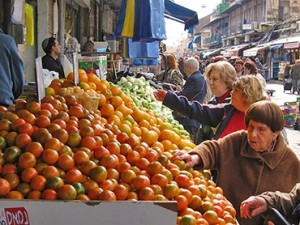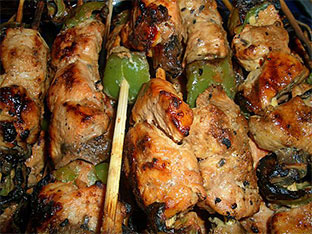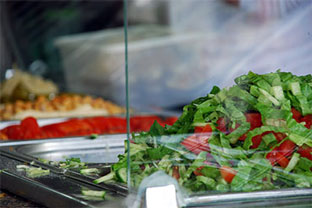The Shuk
Israel Markets – The Shuk
No culinary tour of Israel would be complete without venturing into at least some of the country’s open-air food markets, found in every major city. The shuk (Hebrew, is an important part of Israel’s culinary tradition.

Yoninah CC BY-SA 3.0
Selecting Fruits and Vegetables at Machane Yehuda
Besides offering the locals fresh produce at bargain prices, the market in Israel offers tourists a way to see, taste, smell and hear the various cultures that have made their way to Israel from near and far.
Mahane Yehuda
One of the most famous open-air markets is the Mahane Yehuda in Jerusalem, which dates back to the Ottoman Empire in the 19th century. Here, Arab merchants hawked produce in an empty lot owned by a Sephardic Jewish family. Today, most of the Mahane Yehuda stall owners are Jewish.
Stop by Basher Fromagerie for a beautiful piece of blue-veined Stilton, buy hawaj spice mixture at Pereg, buy halva swirled through with chocolate, or pick up a bag of 10 freshly baked pita pocket breads. Restaurants featuring various ethnic cuisines are a serious temptation. Sundays through Fridays.
Emek Refaim
On Fridays, stop by Jerusalem’s Emek Refaim Farmer’s Market where you can buy handicrafts, preserved lemons, artisanal goat cheeses, cured olives, and more. The market is located at either the Adam School (22 Emek Refaim) or the Mercaz Tarbut Yamim (12 Emek Refaim) all year long (unless it rains) between 9 a.m. and 3 p.m. On any given Friday, 40-50 merchants will be at the farmer’s market and will happily give you tastes of whatever you point to and tell you all about their wares. Want to know more? Call Sarit Dayan 972-52-541-1541.

Tzahy Lerner CC BY-SA 3.0
Pickles and Olives in Carmel Market
Carmel Market
In Tel Aviv’s city center, check out the Carmel Market, daily except for Saturdays. See precariously stacked brightly colored fruits and vegetables and tables sagging under the weight of hot, fresh savory sesame ring cookies called “beigele.” Ask to be pointed toward the local version of filled Middle Eastern pastry known as borekasim (singular: borekas). These flaky filo pastries may be filled with potato, dry salty cheese, spinach, or mushroom fillings.
Tel Aviv Market
Less well-known is the Levinsky Market in Tel Aviv’s Florentin neighborhood. Originally founded by Greek Jews 90 years ago, the street was named after a Lithuanian Jew named Elchanan Leib Levinsky, who immigrated to Palestine during the final two decades of the 19th century. Here, the central focus is on teas and dried spices, some unfamiliar. Let your eyes feast on tall cones of fire-engine red Moroccan oiled paprika, yellow dates still clinging to their branches, and fat, juicy olives in more colors than you knew existed.
Hadar – Haifa
In Haifa’s Hadar district, tourists can choose between the Talpiot shuk or the Wadi Nisnas Arab shuk. The Talpiot shuk is a huge covered market built in the late 1930s by local Jewish residents. Today all signs are in Hebrew and in Russian to accommodate the large influx of Russian immigrants to Israel. Here you can find Thai basil, yellow pears with buttery flesh, and cherry tomatoes sweet as candy and piled high. At Wadi Nisnas, find verdant stacks of greens, herbs, and other wild comestibles that grow naturally in the Galilee, such as the tea herb, Sheba, or wild purslane.

Ofek Sitbon CC BY 2.0
Setting up Shop, Acre Market
Acre Market Turkish Bazaar
Next, check out the Acre (Acco) Market in the Old City, open every day. This market consists of the Turkish Bazaar, built at the end of the 18th century, the Shuk Al-Abiad (the White Market), built in 1817, and Market Street, where you’ll find fresh baklava dripping with syrup and tiny little red-veined fishes known as red mullet, a delicacy whether grilled or fried. After a long day of shopping, stop in at Humus Said and get a bowl of hummus with pita still warm from the oven and some pickled vegetables for piquancy, the perfect Middle Eastern pick-me-up.
At the Netanya Municipal Market in the city center, culinary tourists can find all kinds of interesting food treasures every Tuesday and Friday. Founded by Tunisian and Libyan immigrants during the last part of the 1950s, the market was later inhabited by Russian and French Jews. See gleaming piles of freshly caught fish next to tall displays of airy croissants. Alien-looking celery roots compete for space with fat white cauliflowers and sacks overflowing with tiny orange lentils.
The Shuk: Did You Know?
Bisecting the two major streets of the Mahane Yehuda Shuk are side streets named Afarsek (Peach), Agas (Pear), Egoz (Walnut), Shaked (Almond), Shezif (Plum), Tapuach (Apple), and Tut (Berry) Streets.








